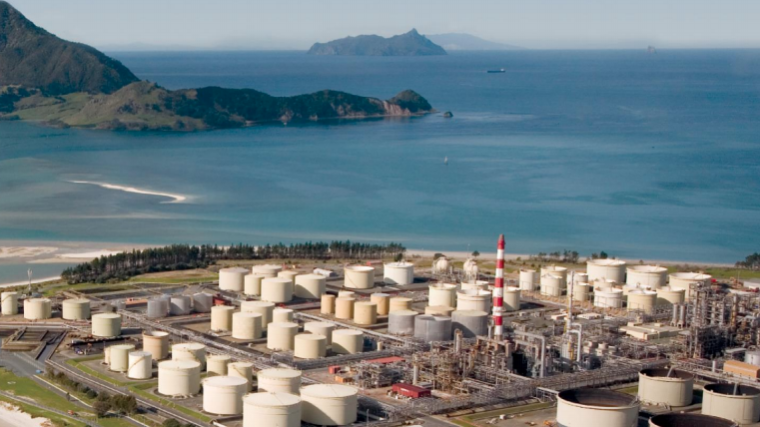
So, what was it New Zealand? Did our economy tank 0.9% in the June quarter? Or was the real GDP figure, as Westpac economists now think, a fall of about 0.1%? And what's the now closed Marsden Point oil refinery got to do with it?
Westpac senior economist Michael Gordon has done a very comprehensive crunch on our GDP figures, trying to get behind why they have in the recent past become so volatile.
And he's come up with what look like compelling and very interesting reasons.
For the March quarter of this year the official figures showed that our GDP rose by a reasonably encouraging 0.9%. However, the June quarter results released last month in a hailstorm of negative publicity showed our economy dropping, stone-like by, well, 0.9%.
Economists generally were disinclined to believe our economy really grew 0.9% in the March quarter and even more disinclined to think it shrank 0.9% in the June quarter. But clear cut reasons were not really on offer.
Now Gordon has drilled down on the stats and produced eminently plausible explanations.
It's very technical, and my apologies for my efforts to simplify.
Fascinatingly, a key reason for the volatility has been the after-effects of the now long-closed Marsden Point oil refinery. This has all got mixed up with the 'chain-linking' statistical method, and with seasonal adjustment.
Here's Gordon's explanation:
Total GDP is not simply the sum of the individual parts. Instead, it uses a more roundabout approach called chain-linking, which works as follows:
- Calculate the percentage change in real (inflationadjusted) output for each industry
- Assign a weight to each industry based on its share of GDP in nominal (dollar value) terms.
- Calculate the weighted-average growth rate.
- Apply this growth rate to the previous level of GDP to get the new level.
As Gordon goes on to say the use of both real and nominal values is what makes the results differ from a straight add-up of output by industry. The difference that we get between the total (chain-linked) GDP and the simple sum of the industries is given the name of "the balancing item".
A point I add here for an attempt at further clarity is that Stats NZ does the chain-linking process first - and then applies seasonal adjustment. The reason for saying that becomes clear shortly.
For the September quarter every year Stats NZ makes its annual revisions to GDP, to incorporate more detailed but less timely information. That includes updating the industry weights that are used in chain-linking.
The weights are drawn from the national accounts for the previous March year, or the latest year for which the data is available.
Things started getting strange
In September of last year, (and this is me talking not Gordon), something pretty screwy started happening and the 'balancing item' started getting way more variable and displaying a marked seasonal pattern.
Here's Gordon again: "What this tells us is that there’s been a change in the seasonality of GDP that the algorithm isn’t fully capturing, which is detracting about 0.5% from reported growth in June quarters while adding about 0.5% in December quarters."
Gordon says it’s a reasonable guess that the change in seasonality stems from a change in the industry weights.
"...We believe that it’s due to the absence of an industry – namely, the closure of the Marsden Point oil refinery, which previously accounted for about 0.6% of GDP," Gordon says.
"Crucially, the refinery’s output had no seasonal pattern to it, so its closure meant a slight increase in the average degree of seasonality across the economy. The use of chain-linking amplified this effect.
"Once the refinery’s weight dropped to zero, this meant that the weights for every other industry – including those that do have strong seasonal patterns – went up.
"The result was that the amplitude of the seasonal pattern in GDP increased by about 0.6 percentage points. That might seem like a small effect, but that’s the magnitude of the change that we’re trying to explain."
The refinery's gone, but its effects linger...
Gordon notes that there is one seeming challenge to this story, namely that the refinery was closed in March 2022 - so why is it only in the last year that it has had this effect on GDP?
"The reason again relates to the chain-linking method: the closure wasn’t reflected in the industry weights until the national accounts for the year ended March 2023. And those figures weren’t available until late 2024, in time to be included in the September quarter 2024 release.
"The last piece of the puzzle is the seasonal adjustment algorithm. Because its calculations are based solely on historic data, it can take several years for it to recognise that a structural change has occurred. Given another few years, the seasonal adjustment would gradually catch up with the new reality, and the volatility in quarterly GDP would dampen down again," Gordon says.
"To sum up: (1) the closure of the refinery increased the average seasonality across industries, (2) the effect was both delayed and amplified by the chain-linking process, and (3) the seasonal adjustment has yet to recognise this change. Not one single cause, but an interaction between three factors, which is what made it so hard to identify."
Okay, so, that's the problem, I think convincingly identified. The solution?
Well, at the moment Stats NZ does the chain-linking first and then does seasonal adjustment. Gordon says you simply swap these steps, IE do the seasonal adjustment first and THEN the chain-linking.
"...By first removing the seasonal pattern from every industry, a change in the industry weights could no longer introduce a new seasonal pattern into the total," Gordon says.
What are the real figures then?
By using this method and also through identifying "some industry-specific timing issues that have had an impact on quarterly growth rates", the Westpac economists have adjusted that 0.9% June quarter GDP drop to just a 0.1% drop, while using the same method they've produced (downwardly adjusted) gains of 0.2% and 0.4% in the two previous quarters.
Gordon says this "still points to a mid-year loss of momentum, but less dramatically than in the official figures".
He says though that while the 0.1% drop they've calculated for the June quarter is "quite different from the -0.9% that was officially reported", it’s still a disappointing result, "coming at a time when we would’ve hoped to see the economy gaining some momentum on the back of lower interest rates".
"And our downward adjustments to the December and March quarters show that the economy’s initial recovery wasn’t all that convincing in the first place."
So, there we have it. Our economy is not doing great, but it didn't tank in the June quarter either.
The truth is stranger.
The aftermath of the closure of the Marsden Point refinery has apparently messed up our measurement of GDP.
17 Comments
This articles link should be forwarded to RBNZ.
You mean Stats NZ? RBNZ doesn't really care about GDP except as an indicator of inflationary pressures.
They seem to care too much about GDP, hence cutting OCR as CPI increasing.
At least the finance minister is reminding them of their singular mandate every step of the way!
No, Stats will set up a review committee probably taking another year to confirm a result. The bank should have sufficient internal nous to sense check it enough to work out any implications for November's OCR review
Michael Gordon and his Westpac chums are in desperation mode trying to save face because their 2.4% growth prediction for 2025 is going to be spectacularly wrong.
I agree. This is real grasping at straws stuff. Very complex and convoluted straws at that. NZ bank economists have been spectacularly wrong in their economic forecasts for the past 2 years. Their stoic refusal to never mention the largest withdrawal of income and investment in the NZ economy since the 1990's is a thing of beauty. The elephant in the room is standing on their feet and they just grit their teeth and take it - without saying a word.
"The aftermath of the closure of the Marsden Point refinery has apparently messed up our measurement of GDP."
It has messed up more than that.
Petrol seems cheap to me.
Petrol was but a subset of what Marsden Point did....and petrol may seem cheap ( and available) currently.
Agreed, I have family who used to work there. So many other products produced that benefitted that also now have to be sourced externally.
Hahahaha!
Good article. Well worth the subscription!
I had seen this pattern in a range of the seasonally adjusted year-on-year stats though and had put it down to a fall in our baseload domestic demand thanks to the rbnz driven recession, and a gradual pickup in the summer economy as visitor numbers pickup.
MMT would argue that New Zealand’s sluggish growth isn’t a statistical artefact — it’s a policy artefact.
Specifically:
-
Fiscal policy has been too tight (government trying to return to surplus).
-
The RBNZ has kept interest rates high, suppressing private investment and spending.
So an MMT critique might be:
“This isn’t about mismeasurement — it’s about macroeconomic policy withdrawing too much net financial support from the private sector.”
In short, GDP weakness reflects a deficit that’s too small, not a data glitch.
In short, GDP weakness reflects a deficit that’s too small, not a data glitch.
I'd say GDP is a foolish measure that doesn't accurately represent the wellbeing of a country. Clearly all of the fuss around how it is calculated, and the omission of certain measures renders it outdated and obsolete. It appears more to me of an organ measuring tool to compare with other countries and encourage them to invest in NZ and prop up our currency, both of which we rely on for our standard of living.
GDP per capita might be an improved measure of economic wellbeing, but ours just keeps sliding.
So...a glitch in the algorithm's ability to cope with out-of-range data?
It's not terribly reassuring that it's taken this long after the fact to work out a plausible solution.
Would it have made a difference if a migration plan for infrastructure development to replace Marsden Point's energy capacity with renewables had been under way to bolster the economy?

We welcome your comments below. If you are not already registered, please register to comment.
Remember we welcome robust, respectful and insightful debate. We don't welcome abusive or defamatory comments and will de-register those repeatedly making such comments. Our current comment policy is here.